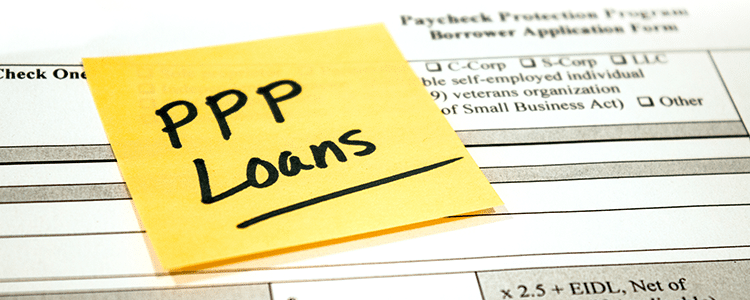Updated May 18, 2020
What is “loan forgiveness”?
The main benefit of the Paycheck Protection Program (PPP) is that if the proceeds from the loan are properly spent within the eight week “Covered Period”—which begins, at the election of the applicant, on the day the PPP proceeds are deposited into the applicant’s bank account or the beginning on the first day of the applicant’s first pay period following their PPP loan disbursement date—it is possible that the entire loan amount is forgiven.
What do you mean by employee and compensation levels must be maintained?
Applicants will be given the option to choose the average full time employee figure to be used for purposes of calculating loan forgiveness by selecting the lower of the: (1) average number of full time employees per month from 2/15/19 – 6/30/19; or (2) average number of full time employees per month from 1/1/20 – 2/29/20. Once this number is chosen, the amount of average full time employees the applicant had during the Covered Period will be divided by the total average number of full time employees the applicant employed pursuant to its selection in (1) or (2) described above. Generally, if employees were reduced during the Covered Period as compared to the number of employees determined by (1) or (2) above, the amount of loan forgiveness will be correspondingly reduced.
In regard to compensation levels, if an employee’s salaries or wages were reduced during the Covered Period, any decrease in those amounts in excess of 25%, will result in a dollar-for-dollar reduction in the forgiveness amount.
Please note, the above summary is merely a high-level description of the mechanics of the forgiveness calculation and should be considered in coordination with the applicant’s financial and accounting records. Given the potential complexity of the calculation, we recommend that each applicant consider on a case-by-case basis the value of engaging a third-party professional to ensure compliance and that the maximum amount of forgiveness is obtained.
What if I already reduced my staff and/or their wages, can I still obtain forgiveness?
Yes, an applicant who received a PPP loan has until June 30, 2020 to restore their full time employment and wage levels for any changes made between February 15, 2020 and April 26, 2020. This is essentially a safe harbor for anyone who wants to obtain full forgiveness, but had previously laid off employees and/or reduced their wages.
If previously laid off employees refuse to return to work, will that reduce the amount of loan forgiveness?
Probably not. Although final guidance from the Treasury Department is forthcoming, it appears that in such a case, the applicant’s amount eligible for forgiveness will not be reduced. This is true so long as the applicant meets the good-faith rehire “safe harbor”. In order to meet this “safe harbor”, for each former employee it wished to rehire, the applicant must document in writing that it made a good faith offer to rehire. In addition, the applicant must also document in writing that the former employee refused to return to work. Applicants should be prepared to submit this documentation to their lender upon its application for loan forgiveness.
How do I go about obtaining loan forgiveness?
On May 15, 2020, the SBA released a “preliminary” PPP loan forgiveness application with detailed instructions. Immediately subsequent to the termination of the applicant’s Covered Period, it can submit a forgiveness request to the lender (i.e., the bank) that serviced the PPP loan. Although it is anticipated that each lender will use a slightly modified version of the SBA’s forgiveness application, in almost every case the forgiveness request must include various documents verifying the number of full-time employees, their pay rates, as well as the payments on eligible mortgage, lease and utility obligations (i.e., bank statements, payroll tax forms [state and federal], payment receipts, canceled checks, etc.). In addition, the applicant must certify that the documents included with the forgiveness applicant are true and that the PPP funds were used as specified on the forgiveness application and its related schedule/worksheet. Therefore, it is critical for business owners (in coordination with their accountants) to maintain detailed and precise records of how each and every dollar received from a PPP loan was spent. More information regarding the practical procedures relating to obtaining loan forgiveness will become more clear as lenders release their specific methods for applicants to obtain forgiveness.
What if I have further questions or need assistance?
FLB’s attorneys have extensive experience in all matters relating to PPP and the CARES Act. We can provide guidance to businesses and business owners faced with these issues brought about by the COVID-19 pandemic, including loan forgiveness. Please contact us using the form below, or give us a call at 610-797-9000. We wish you well during these extraordinary times.
[gravityform id=”11″ title=”false” description=”false”]


